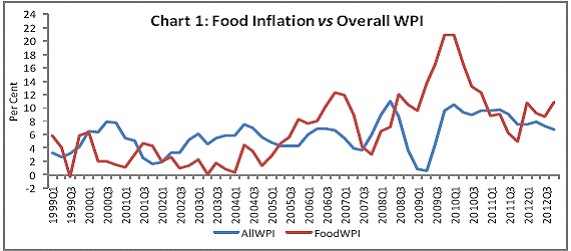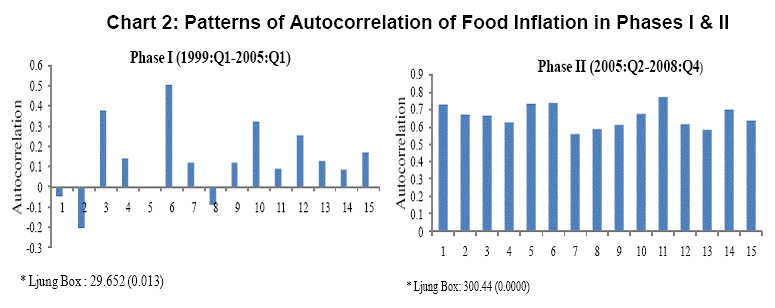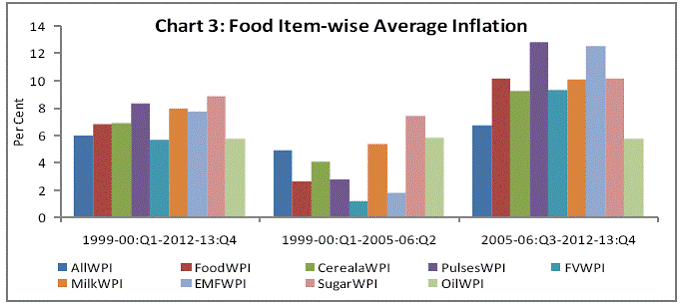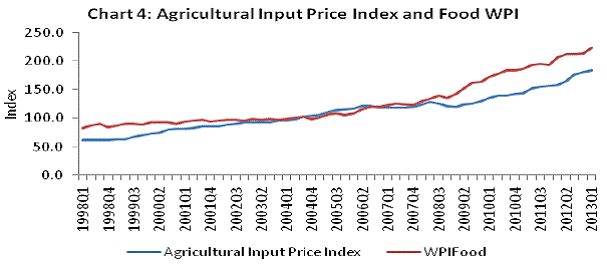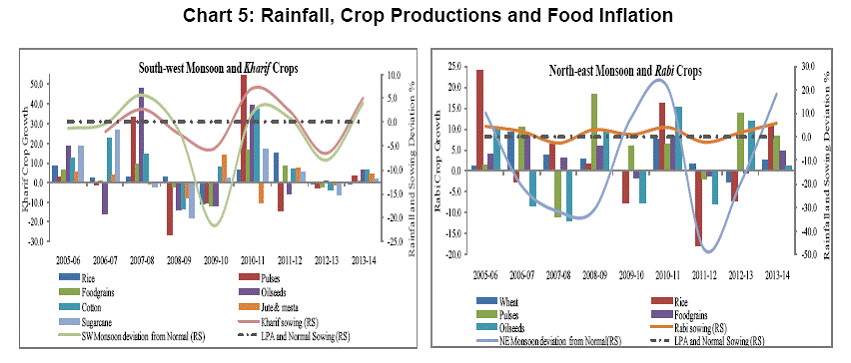 IST,
IST,
RBI WPS (DEPR): 10/2014: Analytics of Food Inflation in India
| RBI Working Paper Series No. 10 Abstract *Food inflation in India has remained stubborn in recent years. A number of proximate factors such as increasing demand particularly arising from higher rural wages, rising agricultural cost of production, changing consumption pattern favoring protein items, increases in minimum support prices (MSPs) and droughts in certain years are believed to have led to higher food inflation. This paper examines the relevance of these factors and finds that increasing real rural wages have played the most dominant role in the determination of overall food inflation in India in the long-run. Though statistically significant, the long-run impact of hikes in MSP of food crops, namely, rice and wheat and input cost inflation (except wages) on food inflation were not as over-bearing as were generally perceived. Similarly, the long-run impact of protein expenditure on food inflation, though significant statistically, was found to be weak. In the short-run, the impact on food inflation stems from the same factors that are important in the long-run viz., increases in rural real wages, MSP and input price pressures. Empirical results indicate that the introduction of MGNREGA does not seem to have caused any significant increase in food inflation as generally perceived. Since the increase in real wages have the largest influence in driving food inflation, it bears to reason that there is a need to raise agricultural productivity in line with the increase in real wages to assuage food price pressures. JEL Classification: E31, E64, Q18 Key Words: Food Inflation, minimum Support Price (MSP), Johansen’s multivariate cointegration, Vector Error Correction Model (VECM) adjustment factors/coefficient, weak exogeneity, causality. Introduction Beginning 2005-06:Q2 till 2012-13:Q4, with the exception of few quarters during 2007-08 and 2011-12, food inflation in terms of wholesale price index (WPI) remained above overall inflation. The quarterly food inflation grew at an average rate of 10.16 per cent during this period compared with 6.76 per cent for overall inflation. In contrast, during the preceding period of five years between 1999-00 till 2005-06, the overall inflation was generally observed to be higher than food inflation. This was the period when inflation in general was low, and the average quarterly food inflation of 2.63 per cent during the period was much lower than the overall inflation rate of 4.90 per cent (Chart 1). It is also observed that higher average food inflation during the latter period was more persistent than the former when the average food inflation was much lower - a fact supported by comparatively larger estimated autocorrelations in the latter than the former period (Chart 2). The observed higher food inflation during the latter phase was generalised across board. Most food items, namely, cereals, pulses, milk, fruits and vegetables, meat-fish-eggs (MFE) and sugar exhibited higher average rates of inflation than overall WPI inflation during the latter period. The average inflation rates for pulses and MFE were even higher than the composite food WPI inflation during the period. Milk and milk products, however, exhibited high rates of inflation during the two periods. Pulses, MFE, and milk and milk products which together constituted around 30 per cent of the total food expenditure in 2009-10 (2004-05=100, as per the 66th NSSO Round) were responsible for around 42 per cent of food inflation during the latter period. This signifies that protein sources of food, both plant and animal, have emerged an important driver of food inflation in recent period (Chart 3). What has brought about this change in the pattern of food inflation? The general perception has been that with rise in income, the expenditure on non-food rise faster than food expenditure. This is owing to the relatively low income elasticity for food expenditure. However, rising income is generally accompanied by increase in preference for higher value and more nutritious food items. This has been the case in the Indian context also as shown by the rising share of higher and more nutritious food items in total food expenditures by the various rounds of NSSOs consumption expenditure surveys. Rising income and the consequent changing preference may have been one of the major factors determining the observed pattern of food inflation in recent years. Another aspect is the structural constraints facing Indian agriculture leading to demand-supply gaps and thus persistent build-up of food price pressure. These constraints are rising population, limited supply and competing uses of cultivable land, low agricultural productivity which remained more or less stagnant during the 2000s. The vagaries of climate change, in particular, the adequacy, spatial and temporal distribution of rainfall together with lack of necessary inputs and mechanization often resulted in fluctuating agricultural production and thus bouts in food prices. Rising personal disposable income, particularly, in rural areas with the implementation of MGNREGA and the steep hikes in MSPs in recent years may have also contributed to increase in and changing composition of demand for food and thus higher food inflation. The role of fiscal and monetary policy, especially the impact of the stimulus packages and the monetary stance in the wake of the global financial crisis have also been ascribed to have also contributed to rising inflation in general. However, these factors have not been put under empirical analysis as to whether they have contributed to food price inflation. It is in this backdrop that an attempt is being made in this study to empirically verify the contribution of these factors to the observed pattern of food inflation during the period (1999-00:Q1 to 2012-13:Q4). Section II surveys the literature on empirical studies on recent experience regarding food inflation in India. Section III describes the data used, Section IV includes the methodology employed and Section V deals with the empirical results. Section VI presents some concluding observations. II. Factors behind Food Inflation in India – A Review of Literature There have been number of empirical and analytical studies in India which have tried to explain the recent trend in food inflation in India. These studies have broadly attributed food inflation in India to supply and demand side factors: Supply side factors One of the traditional explanations for rising food prices has been the supply-side shocks related to weather either because of droughts or floods. Mohanty (2010) argues that drought-led high food prices have contributed significantly to seven out of nine double-digit inflation episodes (between 1956 and 2010) in India. Over the years the volume and spatial distribution of monsoon rains have a significant impact on agricultural production and hence food inflation (Mohanty, 2014). The Reserve Bank of India (RBI) has also emphasized that supply shocks have been the main drivers of inflation (Reserve Bank of India, 2010). Chand (2010) argues that the main reason for India’s high food inflation during 2009 was the supply shocks due to droughts and carryover effect of low growth of food production in 2008–09. In addition to short-run transient supply-side factors, there are also long-term structural supply-side factors which raise food prices such as a shift in land use from food crops to export-oriented commercial crops since the mid-1990s, environmental degradation and the resultant fall in agricultural productivity. A commodity wise analysis of inflation by Nair & Eapen (2012) has found that majority of the commodities was subject to inflationary pressures due to domestic supply-side constraints. With the exception of milk, the paper finds no concrete evidence to support the popular view that the higher food prices in recent years were the outcome of a “secular shift” in food consumption patterns towards high-value agriculture products. Demand side factors As far as demand side is concerned, rising incomes especially rural farm wages (Chand 2010, Mohanty 2013) and increase in real consumption (Mohanty 2013) are highlighted as major reasons. The Indian economy has been growing fast since the opening of the economy in the early 1990s. In addition to the high growth of the economy, the rapidly expanding Indian middle class has been cited as a major cause of the rise in food prices in India in recent years. In his analysis of ‘Changing Inflation Dynamics in India’, Mohanty (2011) demonstrates that average annual monthly per capita expenditure has risen faster in the second half of the 2000s than in the first half. Though the share of per capita food expenditure has decreased during this period, there has been a clear structural shift in food consumption towards protein-based food items in recent years. The prices of these items, including fruits and vegetables, have increased at higher rates than that of cereal products, since the supply side of these products has not been able to meet such a rapid increase in demand (Mohanty, 2011 and 2014). Subbarao (2011), Rajan (2014) and Gokarn (2010 and 2011) have explained the high value food and protein driven food inflation by showing that the change in income distribution and income levels that has taken place in India in recent years, has led the demand for protein-based food items like pulses, eggs, milk and milk products and meat products. Another source of the demand-driven inflation is the expansionary income support offered to the poor through schemes, such as Mahatma Gandhi National Rural Employment Guarantee Scheme (MGNREGA), pay commission awards and other social welfare schemes. These welfare and employment oriented schemes such as MNGREGS have infused substantial amounts of liquidity and purchasing power generating increased demand for food items (Rakshit 2011, Ministry of Agriculture, GoI). Rajan (2014) noted that “a sharp pickup in rural wages was seen after the rural employment guarantee program (assuring 100 days of employment to every household whose adult members volunteer to do unskilled manual work) was enacted. MGNREGA may have contributed to the bargaining power of rural workers, but careful econometric studies suggest that it accounts for only a small fraction of the rural wage increase, and indeed, any effect is waning.That said, the indexation of MGNREGA wages suggests its effects in pushing rural wage inflation will not disappear entirely.” Further, occasional pay commission awards may also have added to the pressure on worker wages in general. Other analysts have also argued that the government sponsored public work, in particular, the MGNREGA has increased the bargaining power of the work force. It is amenable to facts that agricultural wages have shown a sustained increase in recent years. Even after accounting for inflation, real wage increase has been significantly positive (Mohanty, 2014). The increase in agricultural wage was found to be a significant determinant of movements in food prices through its impact on cost of agricultural production (Guha and Tripathi, 2014). Gulati and Saini (2013) using a linear regression framework showed that the three factors i.e. fiscal deficit, rising farm wages and transmission of the global food inflation together accounted for 98 per cent of the food inflation in India during 1995-96 to December, 2012. Among the three factors, fiscal deficit with the coefficient of 0.46 with one year lag was the most prominent, followed by farm wages with the coefficient of 0.32 with one year lag and 0.30 for global food prices, respectively. According to the CII and McKinsey report, India’s per-capita gross domestic product (GDP) would increase by 320 per cent during 2012-2030. This increase in income would lead to 4 per cent increase per annum in overall food consumption from `11 trillion in 2010 to ` 22.5 trillion. In line with this, per-capita consumption is expected to post an annual 3 per cent increase from ` 9,360 to ` 15,390 during the period (CII and McKinsey, April 2013). Some analysts also point out that the genesis of prevailing higher inflationary spiral can be attributed to the lagged impact of monetary and fiscal stimuli provided by authorities to tide over the global financial crisis (Rangarajan and Sheel 2013; Reddy 2013). The unprecedented magnitude and complexity of the challenge necessitated fiscal and monetary stimulus2. In India, two fiscal stimulus packages along with monetary easing programme were resorted to immediately in the aftermath of the eruption of the crisis to manage its fallout which probably resulted in the extant build up of inflationary pressures. Ganguly and Gulati (2013) infer that the fiscal stimulus that the Government of India provided in 2009 to avert economic recession coupled with drought led to rising food prices since mid-2009. Finally the role of MSP in determining the market prices can hardly be overemphasized. The MSP as a concept is sought to be the national floor level price with an open ended operation at which the Government stands ready to buy/procure whatever farmers are ready to sell. As a policy instrument, the MSP is designed for ensuring remunerative and stable price environment which is equitable. However, “since minimum support prices are intended to be a floor for market prices, they have sometimes directly set the market price when increases have been substantial, for key crops the rate of price inflation seems to relate to the increase in MSP in recent years” (Rajan, 2014). Thus, any increases in MSP can set up inflationary pressures in the system (Mishra and Roy, 2011). Gaiha and Kulkarni (2005) showed a strong positive correlation between the level of MSP (for rice and wheat) and WPI as well as CPI-AL after controlling for time trends and level of income. The data used in the empirical analysis includes factors considered relevant for eliciting the determinants of food inflation in India as pointed out by experts and analysts on this subject and highlighted in Section II. These variables include rural wages, consumption expenditure for food and proteins provided by National Accounts Statistics (NAS)3, index of agricultural input cost4, WPI for food, CPI for agricultural labor (CPI-AL), production weighted MSP for rice and wheat and rainfall. Data used in the study have been sourced from official sources, namely, Central Statistics Office (CSO), Ministry of Agriculture (MoA), Reserve Bank of India (RBI) and Commission for Agricultural Costs and Prices (CACP). The quarterly data used in the analysis covers the period 1998-99:Q1 until 2012-13:Q4. Uniform series of all these data were compiled and deseasonalised wherever necessary. Certain data series such as expenditure on protein items from NAS which were only available on yearly basis, were interpolated using standard dynamic programming method to generate quarterly series for the purpose of analysis. Rural wages was converted into real using CPI-AL. The section below gives a brief description of the evolution of some of these important variables during the period under consideration. The rural farm wages grew in real terms, using consumer price index for agricultural labourers (CPI-AL) as deflator, at an average rate of around 0.67 per cent per quarter (Y-o-Y) during the period 2006-07:Q2 till 2012-13:Q4 compared with 0.01 per cent during 1999-00:Q1 to 2006-07:Q1. The average nominal growth rates of rural farm wages being 15.5 per cent and 2.9 per cent, respectively, for the corresponding periods. The latter phase of higher growth of rural farm wages coincided with the phase of higher food price inflation and the implementation of MGNREGA.5 Given these coincidences, it is worth reckoning that given the relatively inelastic demand for food, particularly in rural areas, rising cost of food production and rising farm wages may have contributed to higher food price inflation. This is all the more likely as rural households constituted around 70 per cent of the total population (2011 census) and their demand for food is inelastic. Rising farm wages is believed to be putting severe pressure on cost of production of food while raising the benchmark ‘reservation wage' in the economy - the lowest rate that workers are prepared to accept for jobs across sectors (Damodaran, 2012). It is, therefore quite plausible that the increase in farm wages might have led to an increase in cost of production and demand for food over the period and thus food price inflation, warranting empirical validation. The various rounds of NSSO’s expenditure surveys have shown that in recent period, food consumption pattern in India has undergone a change in favour of high-value and more nutritious food items like milk and milk products, MFE and, fruits and vegetables, away from staple and starch centric cereals. This shift has been accompanied by falling share of food expenditure in total expenditure. Even though empirical validation of changing food consumption pattern is not within the ambit of this study, the observed pattern of compositional shift broadly follows the Bennet’s Law which stated that as income rises food consumption pattern shifts away from starch intensive towards more nutritious and high value food, and the Engel’s law which states that as income rises the proportion of expenditure on food falls. It is, therefore, natural to infer that rising income and the associated change in preferences may have contributed to higher inflation rates for food items like milk and milk products, and MFE during the latter phase. As regard pulses, since the country is not yet self-sufficient in its production, higher inflation for pulses can be assessed in terms of demand-supply mismatch.6 In this regard, the approach paper of the 12th Five Year Plan (TFYP) has rightly pointed out that – “The challenge is how to feed India’s growing population with rising incomes, but limited land and water resources. The economy is expected to grow strongly and, as the various NSSO surveys on household expenditure reveal, an average household still spends nearly half of its expenditure on food and food products. Thus, pressure on food demand is likely to remain strong over the TFYP period while consumption is likely to be more diversified as cereals now account for only 15.0 per cent of the total consumption expenditure.” There has been a significant increase in agricultural cost of production in the recent period. To understand the extent to which increase in cost of production in agriculture has contributed to food price inflation, we have used the agricultural input price index in the analysis. This index includes major farm inputs like fertilisers, pesticides, electricity, high speed diesel, light speed diesel oil, fodder, cattle feed, tractor, agricultural machinery & implements and lubricants. This index shows an upward trend and effectively traces the path of food WPI (Chart 4). Among the agricultural inputs, light diesel oil recorded the highest inflation, followed by high speed diesel and lubricants. In recent years, there have been progressive hikes in the MSPs of major crops. Steep hikes in MSPs were observed across major food items which were evident even when expressed in terms of average annual hikes. The average annual hikes in MSPs for most food items during 2007-13 were higher than during 1998-06. This period of steeper hikes in MSPs also roughly coincided with the period of higher food inflation. There have been studies that observed close correlation between MSP and food price inflation. In the current study, an attempt has been made to capture the impact of MSP in a more comprehensive way by using production weighted MSP for major crops as explanatory variable.7 The vagary of weather and its impact on food production is not a recent phenomenon as far as Indian agriculture is concerned. Years of deficient rainfall have often been associated with fall in agricultural production (Chart 4). Extreme climatic conditions have also affected agricultural production adversely. It has been observed that the sudden slump in food supply associated with climatic conditions has led to food price inflation. However, going by the past experience it has also been the case that rainfall deficiencies have not always been associated with increased food inflation. This implies that deficient rainfall can have at best temporary supply side impact on production and food inflation – and the sustained rise in food inflation observed especially since 2005-06 onwards could be attributed to reasons other than climatic vagaries. The methodology used in the paper is the standard cointegration and error correction modeling based on Johansen’s multivariate cointegration method which entails estimation of vector error correction model (VECM). This method deploys I(1) variables in estimating the cointegrating equation followed by the test of the stationarity of the error term. This is followed by the second step namely, the test of weak exogeneity of the variables in the system. The test is carried out by eliciting the statistical significance of the adjustment factors (coefficients of the error correction terms) in the cointegrating system. Weakly exogenous variables suggest the existence of short-run causality vis-à-vis the dependent variable in the VECM within a robust framework. The basic approach to the conducting cointegration analysis is given below. 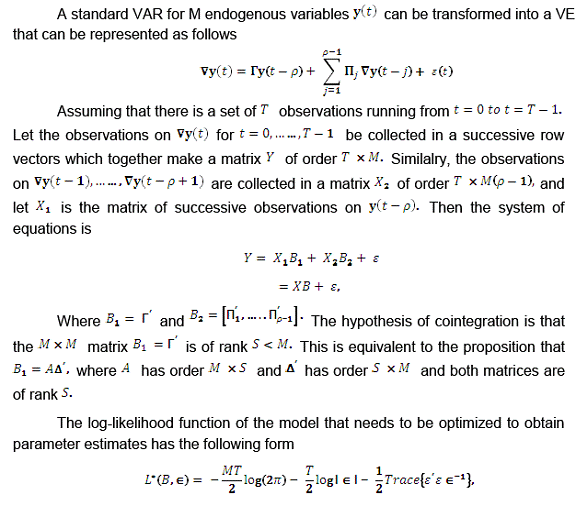 The empirical results are based on the methodology discussed in IV. Accordingly Table I reports the results of the augmented Dickey Fuller (ADF) unit root tests for the variables eventually selected for estimating the model. Table 1 indicates that the variables selected for the cointegrating equation, except for rainfall, are integrated of order one [I(1)] and hence can constitute a long-term equilibrium relationship. The stationarity property of rainfall data series suggests that it can only be considered as a short-run variable, but not as a part of the long-term cointegrating spacer. The estimated cointegrating vector with largest eigenvalue (0.669) was considered for further analysis. The significance of the corresponding Trace statistic (195.85 with p=0.00) confirms the presence of cointegration.  *: significant at 1 per cent. where, FoodWPI : Wholesale price index of food items (2004-05=100) The estimated coefficients of the long-term cointegrating vector/relationship suggest that real rural wages have the largest impact on food inflation, followed by weighted average MSP of rice and wheat and index for agricultural inputs, respectively. The long-term impact of expenditure on protein items on overall food inflation was found to be significant but weak statistically indicating a rather muted influence of these expenditures on overall food inflation. The coefficient of real rural wages of 0.92 implies that food inflation increases almost pari passu with real rural wages giving sound credence to the proposition that rising real rural wages are indeed at the heart of increasing food inflation. The elasticity of average MSP of food inflation estimated to be at 0.34, and that of agricultural input at 0.23 are both statistically significant suggesting that they also have been instrumental in driving food inflation up during the period. The dominant influence of real wages in determining long-run food inflation and especially its visible upward push since mid-2009 appears somehow coincident with large expansion of MGNREGA to 615 districts in 2008-09 from 330 districts in 2007-08. This expansion of MGNREGA resulted in a substantial increase in aggregate expenditure on wages under the programme to ` 18,200 crore in 2008-09 from ` 10,738 crore in 2007-08, giving rise to debate about its adverse implications for food inflation. However, empirical evidence adduced in this study shows that the impact of MGNREGA on food inflation is not sustained. A dummy for controlling MGNREGA expansion effect in 2008-09 introduced in the VECM is not only of small (0.009) magnitude but also statistically insignificant. The sharp upward spike in food inflation beginning mid-2009 should not be therefore ascribed to MGNREGA alone. The second equally important aspect of the analysis consists of the testing of weak exogeneity of each of the system variables with respect to food inflation. Apart from the direction of causality, this test also proffers evidence on what would affect food inflation in the short-run. The procedure is accomplished by testing the significance of adjustment factors as discussed in Section IV. The results of these tests are reported below.
The results from testing weak exogeneity with respect to food inflation suggests that even in the short-run, the three factors, namely, real rural wages, average MSP and agricultural input cost inflation are strongly significant in influencing the former. The study shows that the persistence of food inflation in recent years can largely be ascribed to higher wages, particularly, in the rural sector pushed further by hikes in MSP of rice and wheat and input cost inflation. These very factors also explained the movement of food price in the short-run. The long-term impact of protein expenditure, though large in magnitude, was found to be weakly significant. The vagaries of monsoon have contributed to food price pressures occasionally, but they may not have long-term impact on food prices. Empirical results indicate that the introduction of MGNREGA does not seem to have caused any significant increase in food inflation as generally perceived. The pressure on food prices is likely to increase as economic growth finds durable traction once again. It is therefore necessary to turn agriculture growth into a ‘mission mode’ so as to increase productivity through enhanced investments and improved technology. Needless to state, reducing the supply-demand gap in agriculture production in the long-run and improving supply logistics will be of utmost importance for assuaging food price pressures and for sustaining the pace of economic activity by securing adequate food availability at reasonable prices. @ This paper is prepared by Thangzason Sonna (A.Ad), Dr. Himanshu Joshi (Director), Alice Sebastian (RO) and Upasana Sharma (RO) of the Development Studies Division (DSD) of the Department of Economic and Policy Research (DEPR), Reserve Bank of India (RBI). * The authors are grateful to Smt. Balbir Kaur, Adviser, DEPR for her useful suggestions. The paper reflects personal views of the authors. 2 The stimulus package necessitated temporary deviation from the fiscal consolidation process embodied in the Fiscal Responsibility and Budget Management (FRBM) Act. As part of the stimulus package, special bonds amounting to 1.8 per cent of GDP were issued to oil marketing companies and fertiliser companies during 2008-09 to cover for their under-recoveries in the face of high international prices and lower administered prices to contain the spiralling of inflation. The fiscal correction and consolidation process of the State Governments that was progressing during the previous few years was halted during 2008-09. On the monetary front, the repo and reverse repo rates were raised gradually since September 2004, along with higher reserve requirements. The tightening stance was pursued more aggressively in the first half of 2008-09 to contain the building inflationary pressures but was subsequently relaxed sharply with the unfolding of the global financial crisis in late 2008-09. 3 In India, the private final consumption expenditure (PFCE) is generated from two sources: firstly, as a part of the National Accounts Statistics (NAS), the Central Statistics Office (CSO) compiles annually the estimates of private consumption. Secondly, the Household Consumer Expenditure Surveys (HCES) of the National Sample Survey Organisation (NSSO) yields the estimates of private consumption. The estimates of private consumption from these two sources are different, primarily as these are derived from different approaches. The NSSO estimate consumption expenditure by conducting a survey of selected households whereas the CSO estimate is prepared following “commodity flow” approach. This approach consists of netting out intermediate consumption, change in stocks and exports net of imports from the total value of output to get the net availability of the commodities in the domestic economy. An amount is also discounted for the wastage of agricultural produce. The difference in NSSO and NAS expenditure of food items is less than the difference in the expenditure on non-food items. This study used the NAS based consumption expenditure, primarily due to availability of annual time-series data, extrapolated for quarterly series. The NSSO based consumption expenditure, however, is infrequent and not suitable for robust interpolation/extrapolation. 4 The Index of agricultural input costs was constructed from WPI. The components taken are akin to CACP’s agricultural inputs, namely, fertiliser and pesticides, electricity, high speed diesel, light diesel, lubricants, fodder, cattle feed, tractors, and agricultural machinery and equipments. For this purpose, the weights of the respective components in WPI were normalised to 100 and the price indices aggregated using the new weights for arriving at the composite input cost index. 5 The question of whether MGNREGA was the reason for the higher increase in rural farm wages during the latter phase is an issue still debated in academic circles and is outside the ambit of the current study. 6 According to the Working Group of the 12th Five Year Plan, even by the terminal year of the Plan in 2016-17, the demand-supply gap of pulses would be around 1-4 million tonnes. 7 Taking the average production weighted MSP of food and commercial crops, namely, rice, wheat, pulses, oilseeds and sugarcane as explanatory variables do not yields statistically significant results. Thus, the average production weighted MSP of rice and wheat has been taken as explanatory variable in regression. References 1. Agriculture Statistics at a Glance, Various Issues, Ministry of Agriculture, Government of India, Available at http://eands.dacnet.nic.in/latest_2006.htm. 2. Atul Guha, Ashutosh Kr Tripathi, (2014)., “Link between Food Price Inflation and Rural Wage Dynamics” Economic and Political Weekly, June 28, 2014 (Vol. XLIX Nos. 26 & 27). 3. Bandara J.S., (2013), ‘What is Driving India's Food Inflation? A Survey of Recent Evidence’, South Asia Economic Journal, 14(1), page 127-156. 4. Chand R. (2010), ‘Understanding the Nature and Causes of Food Inflation’, Economic and Political Weekly, volume 45, number 9, page 10-13. 5. Commission for Agricultural Costs and Prices (CACP), Ministry of Agriculture, Government of India, Available at http://cacp.dacnet.nic.in/ 6. Commodity price data (Pink Sheet), World Bank, Available at http://www.worldbank.org/ 7. Damodaran H., “An alternative theory of Inflation” The Hindu June 12, 2012. 8. Gaiha Raghav and Vani S. Kulkarni. 2005, “Foodgrains Surpluses, Yields and Prices in India. Global Forum on Agriculture: Policy Coherence for Development” 30th November -1st December 2005. Paris. France. 9. Ganguly and Gulati (April 2013), “The Political Economy of Food Price Policy – The Case of India”, United Nations University, World Institute for Development Economic Research, Working Paper No.2013/034. 10. Gokarn, S. (2010), ‘The price of protein’. Monthly Bulletin, Reserve Bank of India, November 2010. 11. Gokarn, S. (2011), ‘Food Inflation: This Time it’s Different’ Monthly Bulletin, Reserve Bank of India, January 2011. 12. Ministry of Agriculture, Government of India, “The State of Indian Agriculture 2011-12” Chapter V, Page 126. Available at http://agricoop.nic.in/sia111213312.pdf 13. Gulati and Saini (2013), ‘Taming Food Inflation in India’, Discussion Paper No. 4, Commission for Agricultural Costs and Prices, Ministry of Agriculture, Government of India. 14. Handbook of Statistics on Indian Economy, Various Issues, Reserve Bank of India (RBI), Available at RBI home page /en/web/rbi/home. 15. Mahendra Dev S., Chandrasekhara Rao, “Agricultural Price Policy, Farm Profitability and Food Security: An Analysis of Rice and Wheat”, Available in the homepage of Commission for Agricultural Costs and Prices (CACP), Ministry of Agriculture, Government of India, Available at http://cacp.dacnet.nic.in/ 16. Mishra P. and Roy D. (2011), ‘Explaining Inflation in India: The Role of Food Prices’, Indian Policy Forum, volume 8. 17. Mohanty, D. (2010). ‘Perspectives on inflation in India’. Speech delivered at the Bankers Club, Chennai, on 28 September 2010. 18. Mohanty, D. (2011). ‘Changing inflation dynamics in India’. Speech delivered at the Indian Institute of Technology Guwahati (IITG) on 3 September 2011. 19. Mohanty D. (2013), ‘Indian Inflation Puzzle’, Speech given at the function of Late Dr. Ramchandra Parnerkar Outstanding Economics Award 2013 at Mumbai on January 31. 20. Mohanty, D (2014)., ‘Why is recent food inflation in India so persistent?’. Speech delivered at the annual Lalit Doshi Memorial Lecture, Xavier’s Chapter, delivered at the St. Xavier’s College, Mumbai, 13 January 2014. 21. Nair, Sthanu R and Leena Mary Eapen (2012): “Food Price Inflation in India (2008 to 2010): A Commodity-wise Analysis of the Causal Factors”, Economic & Political Weekly, No 20, 46-64. 22. Price Statistics, Ministry of Statistics and Programme Implementation, Government of India, Available at http://mospi.nic.in/Mospi_New/site/home.aspx 23. Rajan, Raghuram (2014), Governor RBI, (February 26, 2014), “Fighting Inflation”, inaugural speech at FIMMDA-PDAI Annual Conference 2014, on February 26, 2014 at Mumbai. 24. Rakshit, M (2011), “Inflation and Relative Prices in India 2006-10: Some Analytical and Policy Issues”, Economic & Political Weekly, No 16, 41-54. 25. Rangarajan, C and Sheel, Alok (2013), “Growth or Austerity: The Policy Dilemma”, Money & Finance, ICRA Bulletin, February 2013. 26. Reddy, YY (2013). Economic Policies and India's Reform Agenda - A New Thinking. Orient Blackswan. 27. Reserve Bank of India (2010). Annual report 2009–2010. Mumbai: Reserve Bank of India. 28. Subbarao, D., Governor RBI, (November 22, 2011), “The Challenge of Food Inflation”, Presidential Address delivered at the 25th Annual Conference of the Indian Society of Agricultural Marketing at Hyderabad. | |||||||||||||||||||||
പേജ് അവസാനം അപ്ഡേറ്റ് ചെയ്തത്:






